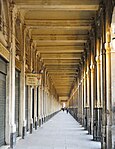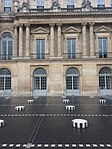Rue Molière
Paris road stubsStreets in the 1st arrondissement of Paris

The rue Molière is a short road in central Paris, in the 1st arrondissement. It begins at avenue de l'Opéra, near the Comédie-Française, and ends at the rue de Richelieu with the Fontaine Molière. It has borne several names, including rue de la Fontaine-Molière, rue Traversière-Saint-Honoré before 1843, earlier the rue Traversine or Traversante, and in 1625 rue de la Brasserie or rue du Bâton-Royal. It is notable for collège Jean-Baptiste-Poquelin, named after the playwright Jean-Baptiste-Poquelin, the real name of Molière.
Excerpt from the Wikipedia article Rue Molière (License: CC BY-SA 3.0, Authors, Images).Rue Molière
Rue Molière, Paris 1st Arrondissement (Paris)
Geographical coordinates (GPS) Address Nearby Places Show on map
Geographical coordinates (GPS)
| Latitude | Longitude |
|---|---|
| N 48.865277777778 ° | E 2.3363888888889 ° |
Address
Rue Molière 22
75001 Paris, 1st Arrondissement (Paris)
Ile-de-France, France
Open on Google Maps











